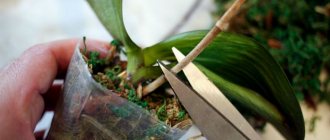Description
The homeland of Campanula is the Mediterranean.
It is distributed throughout Europe and Asia. The flower grows well in the steppe, forest plantations, meadows and rocky plateaus. The shape of the flower (white, blue, blue or white) resembles a 5-petal bell, the diameter of which is about 4 cm; the plant can reach 50 cm in height. The shape of the leaf blades is heart-shaped, up to 7 cm long, the petioles are long.
Characterized by decorativeness and durability, grown as a 1-, 2-, or perennial.
The variety with blue and white flowers (“Bride and Groom”) is known as “flowers of family happiness.” There is a sign that if such a houseplant is given to newlyweds, there will always be agreement between them, and there will be happiness and prosperity in their home.
It is believed that a girl caring for a campanula will meet her betrothed, and an elderly man will live in peace and serenity. The flower brings warmth and comfort to the house, has a positive effect on the microclimate of the home, material well-being and stimulates the creativity of its owner.
Diseases and pests
Campanula is resistant to diseases and pests. However, if not properly cared for, it can be affected by spider mites, scale insects, aphids and scale insects.
Common diseases include gray and root rot. If signs of illness are detected, a number of urgent measures should be taken:
- remove damaged parts of plants;
- reduce the number of waterings;
- carry out treatment with fungicidal agents: “Fitosporin”, copper sulfate, “Fitolavin”.
To combat insect pests, plants should be systematically inspected, as well as preventive treatment with a solution of laundry soap or tobacco chips and insecticidal preparations.
Types and varieties
Campanula gemina
Campanula gemina
The variety was obtained by crossing Campanula Spoon-leaved and Carpathian. The leaf blades are round, the stems are thin and flexible, the flowers are of various shades of white and purple, an ampelous plant.
Campanula glomerata
Campanula glomerata
The bush is loose and erect. The dark green leaf blades at the base of the stem have an elongated heart-shaped shape; the leaves on the stem are wide, lanceolate, and the plant is pubescent. Flowers are collected in twisted heads at the end of the stem, in the axils of the upper leaf blades.
Campanula blauranke
Campanula blauranke
A variety of Campanula Pozharsky. The height of the bush is up to 20 cm, but the plant is distinguished by large light blue flowers and leaf blades.
Carpathian Campanula (Campanula carpática)
Carpathian Campanula (Campanula carpática)
The bush reaches a height of 30 cm. The shape of the leaf blades is ovoid, the leaves form a basal rosette. The flowers are lilac-blue, about 5 cm in diameter, bloom all summer.
Campanula isophylla
Campanula isophylla
Indoor plants of this variety are called “bride and groom”. The hybrid "Mayi" produces blue flowers, "Alba" produces white flowers. The shoots are thin, creeping, their length can be 25 cm, heart-shaped leaf blades sit on long petioles. Blooms in summer. Star-shaped flowers in shades of white, purple and white bloom at the ends of the stems.
Campanula mix
Campanula mix
These are plants of the same variety, characterized by different shades of flowers.
How to deal with Campanula diseases
Mother-in-law's tongue flower - home care
The appearance of problems with a flower indicates improper care. If the watering regime is violated, the plant becomes infected with fungi. To eliminate the lesion, watering should be reduced.
Scale insects on leaves
Spider mites and scale insects may also appear on the plant. To eliminate pests, the flower is treated with an insecticide; you can also wash them off with warm running water.
Features of cultivation
Location and lighting
The plant is light-loving, but you should not place the flowerpot in direct sunlight. The optimal solution would be to place the campanula on an east or west window. This indoor culture does not like drafts. In spring, the pot with the plant can be taken out onto the balcony or into the garden. Campanula is brought back into the room in September.
Soil selection
The soil should be loamy, well-drained, loose. If the soil solution is acidic, you need to add lime to the soil. The soil substrate consists of a mixture of turf soil, sand, compost and peat in a ratio of 3:1:2:1.
Air temperature and humidity
Temperature conditions are moderate, not higher than +22 degrees. In winter, the room temperature must be maintained in the range of +12…+14 degrees. Campanula is undemanding to air humidity.
Watering
In spring and summer, during the phase of active growth and flowering, watering should be plentiful. In autumn, the intensity of watering is reduced. In winter, water infrequently.
Transfer
Transplantation is carried out in the spring. Since Campanula has a short life cycle, new cuttings are planted in early spring.
If you purchased a flowering plant, place it in a cool room for 1 week to adapt, and then replant it using the transshipment method.
Fertilizers and fertilizers
When new shoots and flowers form, the plant is fed with special microfertilizers every 15-20 days. You can occasionally sprinkle wood ash under the roots.
Trimming
In autumn, the shoots of the plant need to be cut off by half, in the spring the procedure is repeated, leaving 5 cm in length. New shoots will grow from dormant buds at the base.
Preparing perennials for winter
In the central zone of the country, the perennial is able to withstand winter well. To do this, it must be prepared in October:
- stems are trimmed;
- The soil under the campanula is generously sprinkled with dry leaves to protect the root system from frost.
Despite the fact that campanula is a perennial, the plant requires renewal, since in a couple of years the bush disappears without it.
Planting and caring for campanula in the garden is not very difficult. In order for a flower to delight with abundant blooms, it is necessary to follow the recommendations for the maintenance of the plant - water, apply fertilizers, avoid drafts and stagnation of moisture in the soil.
Reproduction methods
Dividing the bush
When replanting an overgrown bush, it is divided into sections. Remove the plant along with a lump of earth from the container and divide it into several parts with a knife. The sections are sprinkled with charcoal powder, the sections are planted in separate flowerpots, watered with settled water and placed in a shaded place.
Seeds
In March, the seeds are sown in pots, and in mid-May, the seedlings are transplanted into soil or flowerpots and taken out into the garden. The procedure is carried out in stages:
- select seed material with good germination - sow a small batch of seeds and observe their germination;
- prepare containers for planting, purchase or independently produce a suitable soil substrate;
- fill containers with soil, do not compact them, level the surface, sow seeds;
- crush the seeds with soil and irrigate with water;
- Weak shoots are discarded and the strongest ones are left.
Cuttings
This method of reproduction goes like this:
- cut off a shoot with leaves from the bottom of the plant;
- place in a highly diluted solution of potassium permanganate for 10 hours, and then place in a container with water;
- after new roots are formed, planted in prepared soil substrate;
- cover with glass or film, irrigate with settled water once every 7 days.
Campanula or "Bride and Groom". Home care
Campanula or "Bride and Groom". Home care
Today we will get to know Campanula . Let's find out what kind of flower it is, its cultivation characteristics and how to care for it at home .
Campanula the Bride and Groom since ancient times , is simply an incredibly beautiful and delicate indoor flower . It is also called the indoor bell because of the shape of its flowers. Campanula simply fits perfectly into absolutely any interior and will decorate any room. Campanula looks especially beautiful in a flower pot .
Previously, Campanula could be seen in almost any home. But now the beautiful flower has become a little forgotten, although in recent years it has begun to regain its popularity.
Origin of Campanula
It is believed that the homeland of Campanula is the Mediterranean, but you can find this beautiful plant in the wild nature of the Caucasus, Southern Europe, the Carpathians and also in some countries of North America. Therefore, the question of its place of origin is quite controversial.
In nature, it grows on mountain slopes, forest clearings, and on the banks of rivers and lakes. But you can grow this beauty at home.
Botanical description of Campanula indoors
When planting any plant at home, you need to know its botanical description, at least so that you are not deceived and you give your money for exactly the plant you want to purchase.
Campanula blue. Groom
The foliage of Campanula is dark green or simply green in color. The foliage has a shape similar to a clover leaf or, depending on the variety, ovoid. The leaves have a long leaf stalk.
The height of an adult plant can reach from 20 to 50 centimeters. The branches hang down, so these flowers always require hanging, they hang down like a waterfall.
Flowers come in several different shapes. They can be in the form of small or large bells, and the flowers can also be full terry. The color of the flowers is white, blue or lilac.
The root system is thin and extensive.
Planting indoor Campanula
Planting indoor Campanula is a fairly simple process and is not much different from planting other indoor plants.
Soil for planting Campanula
Campanula requires light and loose soil. It is best to purchase soil for planting it in a specialized store. Universal soil for indoor plants with peat is perfect; it is very light and quite loose, and it also contains a lot of nutrients to start its growth.
Container for planting Campanula
Campanula does not require much space to grow; on the contrary, it is much more comfortable in a small container. For ideal growth, its roots must completely entwine the earthen ball.
Campanula white. Bride
But if you notice that it is already really cramped, then choose a replacement container that is only 2 centimeters larger than the previous one. You cannot choose a larger diameter, otherwise the flower will devote all its energy to building up the horse system.
For planting Campanula, a low but wide flowerpot or hanging pot is ideal; it is these flowerpots or containers that are suitable for Campanula for its full growth and abundant flowering.
Reproduction of Campanula
Campanula can be propagated in three ways - seeds, cuttings and dividing the bush.
Reproduction of Campanula indoors by seeds
For planting, you can purchase indoor Campanula seeds at any specialty store.
Campanula terry (blue)
Take a suitable container to plant the seeds. Fill it with soil, then sow the seeds, cover them a little with soil, no more than 1 centimeter. Then water them generously.
To speed up germination, cover the container with film or glass, creating an impromptu greenhouse. When you see shoots at least 0.5 cm high, immediately remove the film or glass. While the seeds are germinating, carefully ensure that the soil is constantly moist.
Then place the container in a sunny place, but not in direct sunlight. When the seedlings reach a size of 2-3 centimeters, you can plant them in flowerpots. If you want a dense bush, then you can immediately plant the seeds in a permanent flowerpot, then they will not need replanting.
Reproduction of Campanula indoors by cuttings
It is very easy to propagate Campanula from cuttings. It is enough to cut a small branch from it, but it must be cut very low at the root heel. Then place the cutting in water for it to take root, usually within 10 days. When it has grown roots of at least 2-3 centimeters, you can start planting it in a container.
Reproduction of Campanula indoors by dividing the bush
If you already have a large enough bush, you can divide it into several parts and get several good plants at once. To do this, you need to remove the plant from the flowerpot along with the earthen lump. Then lower it into water at room temperature and carefully wash off all the soil from the horses, then rinse them under running water to remove any remaining soil. Next, carefully trying not to tear the roots too much, divide the bush into several parts. Then plant each part of the bush separately as an independent plant.
What to do after purchasing Campanula indoors?
Having bought a beautiful flowering shrub, we usually place it in the chosen place, and there it stands until the need for replanting arises. But such actions will lead to the fact that within a week you will see how Campanula begins to dry out and disappear.
Campanula terry (white)
After purchase, it simply needs to be replanted within 2-3 days. And not transfer it to another pot, but replant it, removing all the soil in which it grew.
To do this, take a suitable container or flowerpot. Carefully remove the flower with the lump, then carefully shake off the earthen lump, trying to damage the root system as little as possible.
Next, pour drainage in the form of expanded clay into the container, fill it with a little soil, lower the roots and fill it with soil to the end. Then water it generously. And send the flower to partial shade for 2 days to adapt.
Caring for Indoor Campanula
Campanula is not demanding to care for, but, like any plant, it has its own characteristics.
Campanula location and lighting
Campanula is a plant that does not tolerate heat well, so it is better to place it in the east, west or even north; it does not tolerate the south side quite well.
This flower loves a lot of light, but does not tolerate direct sunlight. Therefore, it will be best for him where he will receive enough diffused sunlight, but there will be no direct rays.
She also does not survive cold drafts well; in such a place she can die very quickly.
Fertilizing indoor Campanula
Campanula, like all indoor plants, needs regular feeding. During the flowering period, it must be fed every 10 days. Fertilizing is carried out by watering using any fertilizer for flowering indoor plants.
After flowering, fertilizing is carried out much less frequently, or rather once a month.
During the dormant period, fertilizers are not applied.
Watering indoor Campanula
Campanula needs regular, high-quality watering. During the flowering period, it is necessary to water thoroughly and not allow it to dry out. However, do not overdo it, watering is carried out from above and when the water drains into the pan it pours out; water stagnation should not be allowed.
After flowering ends, the intensity of watering decreases.
Pruning Campanula indoors
The drop needs to be pruned. But it is not the stems that need to be trimmed, but the drying bells that have already bloomed. If you leave them and wait until they fall off on their own, then by doing this you will reduce flowering. On the contrary, pruning will stimulate its flowering.
Dry shoots must also be trimmed. In winter, you can remove excess shoots if necessary. Also, for the dormant period, the shoots are shortened by a third.
Temperature conditions for room Campanula
Campanula is not a fan of heat, she does not like it. Ideal summer temperature is +20…+24°C. In winter, she feels great at a temperature of +12...+15°C. Therefore, do not try to look for a warmer place for her in winter, she will be very happy with the coolness.
The dormant period of Campanula indoors
Campanula has its own dormant period. If she has the opportunity to rest well, then later she will give you abundant and long-lasting flowering.
Campanula violet
The period when it needs rest begins at the end of October or beginning of November, depending on the end of flowering. During the dormant period, the branches are cut to a length of 14 centimeters.
It is very important to leave 4-5 internodes on the branch, it is from these that new young strong branches will then grow. At the same time, watering is reduced and the application of fertilizers is completely stopped. In March, it is necessary to inspect the growing shoots and remove all weak or fading shoots.
If you provide Campanula with a period of rest, it will bloom profusely in late April or early May and will continue to bloom until October.
Updating Campanula indoors
Even though the Campanula plant is a perennial plant, it still needs to be renewed periodically to stay healthy. It is recommended to update it every 2-3 years. This is very easy to do. It is enough to cut it or divide the bush. You can also collect the seeds yourself and plant a new plant. If you do not update, flowering will decrease every year and the flower itself will lose its decorative effect.
Is it necessary to leave the Bride and Groom together?
Campanula is also called Bride and Groom. A flower with white flowers is considered the bride, and one with blue flowers is considered the groom.
The Bride and Groom should stand together
The question often arises: are they really only planted together?
Answer: Yes, the Bride and Groom should always be close. The fact is that these are flowers of male and female forms. They have cross-pollination and that is why apart these flowers can stop flowering and begin to fade.
The second question, which often arises. Is it possible to plant them mixed in one pot?
Answer: Absolutely not. The fact is that the Bride is a stronger plant than the Groom and she will take nutrients from the Groom and he will quickly begin to fade.
This is how she is - the beautiful Campanula! Easy to care for and simply charming to bloom.
Possible problems
When growing this beautiful plant, sometimes you have to face the following problems:
- the leaf blades become faded or acquire a yellow tint - the flower may grow in the wrong place. It is necessary to choose a place suitable for its growing conditions, to prevent sunlight from entering the plant;
- the stems stretch out and become thinner - the reason is insufficient lighting;
- the foliage fades - the intensity of watering should be reduced.
What is perennial garden campanula?
The homeland of this beautiful flower is the Mediterranean. Regions with a temperate climate are suitable for growing campanula.
The stem of Campanula can be creeping or erect, up to 100 cm long. Flowering begins in the first summer month and continues until September. The color of the flower depends on the variety; it can be white, pink, blue, or purple.
A feature of growing perennial garden campanula is the need to organize good watering. In this case, drainage must be provided so that the root system does not rot from excess moisture.
Timely removal of wilted flowers stimulates abundant flowering.
Campanula pruning
When the plant's dormant period begins, around the end of October - beginning of December, you can shorten the stems of the plant to 10 - 12 cm. It is quite possible that after such pruning your campanula will bloom, if, of course, you leave it to overwinter in a sunny window.
At the beginning of spring, inspect the plant, remove dried stems and leaves and trim the shoots again, leaving about 5 cm in length. The fact is that at the base of the shoots there are many dormant buds hidden, from which new strong shoots will appear with the onset of spring.
Rules of care
Watering:
- in summer - every morning or evening;
- in winter - once a week.
Top dressing
- every 2 weeks from early spring to early autumn. Fertilizers are suitable for violets.
Ways to stimulate flowering:
- cut off faded flowers;
- in winter, place in a cool place, but with good lighting, reduce watering;
- In spring, pinch out young shoots.
Bush formation
. When planting, it is necessary to cut off the shoots at a height from the root: 2-3 cm
Small cup volume
For rooting, the shoots are planted in small cups with a volume of no more than 50 ml. If you want to plant a white and a blue flower at the same time, then you need to make a partition between them, because the more resilient “bride” will crowd out the modest “groom”, preventing him from developing.
There is no need to think that a spacious container will allow you to quickly get a new young bush.
The shoot will stretch upward without growing in width. The roots of Campanula are thin, thread-like, they will not be able to develop the territory and absorb all the moisture. A white coating will appear on the surface, the plant will hurt and rot.
Transfer rules
Priming
Campanula prefers light and loose soil, for example a mixture of leaf soil and peat - 1:1, or universal soil.
Pot
For maximum flowering, the bluebell needs a small, tight container so that the roots can entwine the soil. When replanting, it is necessary to take the pot only 1-2 cm deeper.
Transplantation step by step
The transplant must be carried out:
- Mandatory after purchasing a campanula - with a complete replacement of the soil. Before the procedure, you need to cut off all flowers and buds, and shorten the shoots.
- Then, when the roots became visible from the holes of the pot.
Once every two years, in the spring (before flowering), you need to divide the bush and plant the bell.
- Lay a drainage layer - ¼ of the pot.
- Fill in the nutrient substrate - ½ of the pot.
- Remove the plant from the container, clean the rhizome from the soil, rinse, and cut off damaged ones.
- Place the bush in a new container, straighten the roots, cover with soil, water, and place in partial shade for 2-3 days.
- Move to a permanent location.
Campanula. (Photo used from myfavouritebells.com)

![Tinkoff (Debit card) [CPS] RU](https://parnikpodsneznik.ru/wp-content/uploads/tinkoff-debetovaya-karta-cps-ru4-330x140.jpg)









